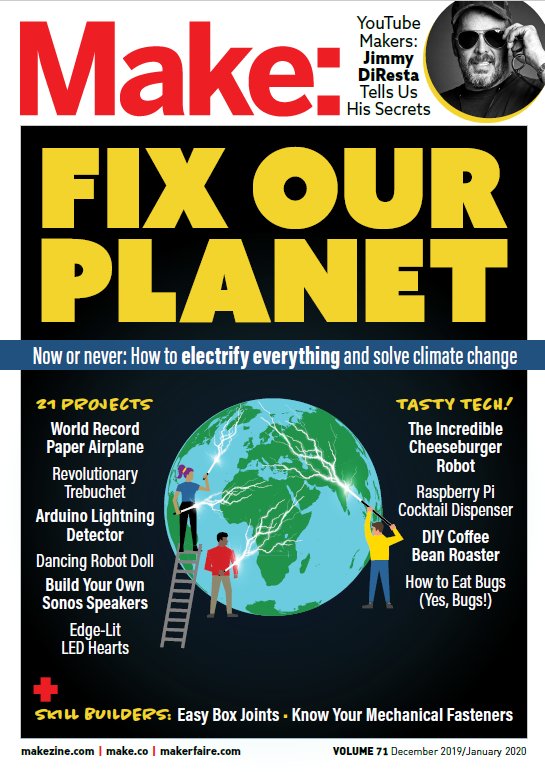The Maker Movement Unmade? Part 7: Make: Community Responds
To conclude our series on the transformation of the maker movement, we’re going full circle to the place that inspired this series in the first place: Make: Community (previously known as Maker Media). As previously conveyed in our last two installments (part 5 and part 6), the maker movement is clearly not dead, and neither is Maker Media. That isn’t to say that things don’t change.
We spoke to Dale Dougherty, founder and former CEO of Maker Media and now president of Make: Community, to understand the state of the maker movement from one of the most prominent brands in that movement, as well as the current story of Make:.
One reason that this author may have had a misconception about the vitality of the open source hardware community, according to Dougherty, is that we are particularly focused on one aspect of that community: 3D printing.
“One way of looking at 3D printing is as an industry. 3D printing has existed since the 1980s and, when the maker movement came along, makers inside of [the industry]—the MakerBot team and the RepRap team before that thought that 3D printing was something everybody could use. They dove in and tried to make a machine that more people could use. By taking an industrial machine and making it affordable for consumers/makers, was a really big thing,” Dougherty said. “It also generated a lot of hype around 3D printing. Companies made acquisitions and raised their stock price. Then it all kind of crashed in a way. But there are probably more 3D printers in the world in use today than ever before. Sometimes we miss that because we’re just following the industry and the business of it is.”
What Dougherty thought this author may have been picking up on was a leveling out of the hype curve related to 3D printing. And by saying that the maker movement was unmade was akin to articles that heralded the death of the internet and computers. In actuality, he believes that the maker movement doesn’t necessarily move at the same pace as the market. Instead of focusing on the relative commercial success of a given open source hardware company, he thinks it’s important to highlight the level of impact the maker movement has had on education.
“The thing I’m most proud of today is the way that the maker movement has influenced education,” Dougherty said, “and the number of makerspaces at all levels, from K-12 to higher ed—community colleges included. It’s helping to shape an educational experience that really didn’t exist prior. And I think that will give more people the opportunity to become innovators and find meaningful work in the 21st century.”
As for the state of his own company’s role in the maker movement, Dougherty said, “We’re doing fine. We went through a difficult transition in the summer, but the outcome has been very positive.”
For a recap, in spring and summer of 2019, Maker Media laid off all of its staff due to a lack of financial resources. The financial issues Maker Media encountered were the result of investors who wanted to pull out of the company, according to Dougherty. Like any publishing or event company, Maker Media had its share of challenges in the current economy. As a business, Maker Media was break-even financially; however, the venture capital backers were hoping for bigger returns.
“I certainly could have taken a similar approach and said, ‘okay, I’m done, too,’ but I believe in this,” Dougherty said. “I think this is terribly important for the world, for people and for the community that we’ve created. So, I want to find ways to keep going. I’ve got a team of 16 people many who, most of them who worked with me previously, and are committed to doing this work, as well.”
The Maker Media founder struggled to find a buyer to save the business and operations ceased in June. Rather than let the company go, Dougherty acquired the assets and put them into a new entity called Make: Community, where he was able to re-hire the majority of those let go earlier in the year.
As indicators of good health, the company has licensed its brand to and supported 82 Maker Faires globally. Two issues of Make: magazine have been produced and sent to subscribers. Make: also published a book recently titled Mechanical Engineering for Makers.
Make: Community is currently in the process of determining its organizational and legal structure. Dougherty says that it won’t purely operate as a nonprofit and may be established as a public benefit corporation. Ultimately, he envisions Make: Community as becoming community owned.
“I’m the sole stakeholder right now. I can do that for a while. If we are able to sustain ourselves, that’s fine. But, ultimately, I want to develop a structure that reflects our mission, obligations, and responsibilities to the community.”
That mission, Dougherty says, is “to connect makers, identify makers, create makers and connect them to each other. And that’s why, when I look back at what we’ve done over the past 15 years, I don’t see us as a publishing company or an event company. I see us as a community building company that is there to serve that community.”
“The maker movement is not an industry. To some degree, even Maker Media as a business, whether it succeeds or fails, doesn’t necessarily reflect on the movement. There are lots of different players and we may have different lives in it, but I hope what we’re doing is it’s showing people that there’s a real potential here for them to use technology to make the world better—not just talk about it, but actually do it,” Dougherty concluded. “My own interest is in figuring out a way that we can make that happen, whether it’s through a business, like Make Community or other things.”
There are a lot of things on this planet that need to be made better, not the least of which are: the ongoing climate and biodiversity emergencies, U.S. imperialism, and globally inequality. For the sake of the planet and all life on it, we hope that Dougherty is right.
Subscribe to Our Email Newsletter
Stay up-to-date on all the latest news from the 3D printing industry and receive information and offers from third party vendors.
Print Services
You May Also Like
3D Printing Grows to $15.9B in 2024 Amid Shifting Industry Dynamics
The global additive manufacturing (AM) market reached $15.9 billion in calendar year 2024, according to “Q4 2024 3DP/AM Market Data and Forecast” from Additive Manufacturing Research (AM Research). Despite a...
3DPOD 247: LJ Holmes, Executive Director for the Center of Advanced Manufacturing and Materials at Harrisburg University
Executive Director for the Center of Advanced Manufacturing and Materials at Harrisburg University, Larry “LJ” Holmes is a pioneer in applying additive manufacturing to defense and other critical sectors. Part...
Thai Startup OsseoLabs to Cut Surgery Time with 3D Printed Magnesium Implants
A patient undergoing mandibular reconstructive surgery typically faces two separate operations: one to place a custom-fit titanium plate and another month later to remove it. But what if that second...
Japanese Advanced Manufacturing Capabilities Grow in Europe with Sodick’s Purchase of Prima Additive
The global economy is currently undergoing a reshuffling in terms of what gets manufactured where. In large part, this trend is being driven by new geopolitical alliances and the need...



























